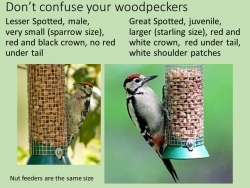We are very pleased that the UK Rare Birds Breeding Panel @ukrbbp has recognised the difficulty in collecting data and monitoring some rare breeding birds such as Lesser Spotted Woodpeckers and has appointed Ken Smith as Species Advisor for LSW to provide advice and encourage targeted recording.
More information on Ken’s appointment and the other species champions is on RBBP website https://rbbp.org.uk/2022/02/04/introducing-rbbp-species-advisors/
The current British population of Lesser Spots is estimated at around 2,000 pairs. So we need to find out more about their distribution, abundance and breeding success.
The plans for 2022 include encouraging all volunteers to go out from mid-February onwards and look and listen for Lesser Spots.
Lesser Spots are visible at this time of year when there are no leaves on the trees. Both male and female Lesser Spots will be drumming and they are also vocal with their distinctive kee-kee-kee call.
Please make a note of the date, time and the location and report the record to Woodpecker Network, via this website or a Twitter DM to @LesserSpotNet as well as to your local county recorder (via BTO BirdTrack or other reporting system).
If you would prefer not to give the full grid reference, recording the 1 kilometre square is enough, for example SU2609 Acres Down, New Forest. Lesser Spots breeding territories are about one square kilometre in area, so this will give a good estimate of the population.
If you can follow your birds through the breeding season you may find them excavating a nest cavity in April or May and/or find an active nest in May or June. Monitoring the nest to record breeding outcomes gives critical information on breeding success.

Read more about how the population was estimated here how many Lesser Spots are there in Britain news item




